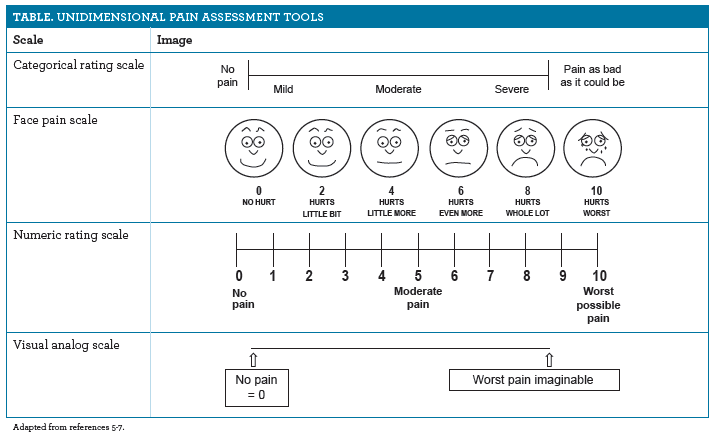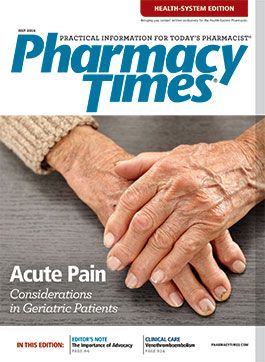Publication
Article
Pharmacy Practice in Focus: Health Systems
Acute Pain: Considerations in Geriatric Patients
Acute pain is the body's normal response to noxious stimuli.
Acute pain is the body’s normal response to noxious stimuli. Acute pain typically lasts for days to weeks, but it may last for months during the healing process.1,2 Because pain is a highly subjective experience, it is important for a thorough assessment to be conducted to determine the cause of pain and the most appropriate course of treatment. A pain management plan should consider the assessment of pain and all pertinent patient factors, as well as drug and nondrug measures that can be employed to relieve a patient’s pain. When a medication is selected to treat pain in a geriatric patient, factors that should be considered include drug metabolism mechanism, renal or kidney function, concomitant medical conditions, and social history, including the potential for drug abuse or history of addiction. If an assessment takes place in a community pharmacy setting, it is important to consider when a patient may require referral to a health care provider for a more in-depth acute pain evaluation.3,4
Assessment of Pain
The assessment of pain requires a multidimensional approach by clinicians because pain can present in many different ways and can affect patients physically and psychologically. A patient’s report of pain, in his or her own words, is the most reliable indicator of pain. A thorough pain assessment should inquire about the characteristics of the pain, past and current management strategies, medical history, family history, psychosocial concerns, and the patient’s goals and expectations for pain management. Characteristics of pain may include location and distribution, duration and periodicity, quality, and associated signs or symptoms.
Pain may be assessed using a unidimensional or multidimensional tool. Unidimensional scales are useful for a quick measurement of the intensity of an individual’s pain. The most common unidimensional pain assessment tools are the numeric rating scale, the visual rating scale, or a categorical rating scale. The Table5-7 provides illustrations of unidimensional pain assessment tools. Because of potential “oversimplification of the pain problem” when using only unidimensional pain assessment tools, experts often prefer to use a multidimensional pain assessment tool. Multidimensional tools offer the advantage of providing information on characteristics of pain, in addition to pain intensity. They may be provided in a visual, verbal, or written format. Examples of multidimensional assessment tools include the initial pain assessment tool, a brief pain inventory, the McGill pain questionnaire, a memorial pain assessment card, and a pain drawing.

Elderly patients, in particular, may have difficulty articulating an accurate description of their pain for several reasons. It is common for this population of patients to underreport their pain due to fear, cultural factors, or stoicism. Changes in the patterns of an individual’s activities of daily living, such as walking or participating in social activities, may be an indicator of unrelieved pain. Elderly patients should be assessed for hearing, vision, or verbal impairments that may affect the assessment technique. When assessing pain in elderly patients, ensure that enough time has been allocated to perform a thorough assessment and that the tool selected is amendable to the needs of the patient.4,8
The Analgesic Menu
Nonsteroidal Anti-Inflammatory Drugs
Nonsteroidal anti-inflammatory drugs (NSAIDs) are best used to treat pain that is inflammatory in nature, such as muscle sprains or strains.9 Particular patients who should be cautious of NSAID use include those who are at risk for cardiovascular events (eg, heart attack, stroke), those with high blood pressure, and those with renal impairment.10 NSAIDs contribute to elevated blood pressure, even if only used for 1 week.11 If an NSAID must be used in someone with a high cardiovascular risk, naproxen is the agent of choice. Patients with a high cardiovascular risk who take aspirin for cardioprotection should use NSAIDs with caution, as they may interfere with the antiplatelet effect of aspirin. Because the clearance of NSAIDs is affected by renal function, individuals with poor renal function should use NSAIDs cautiously. NSAIDs also increase the risk of gastrointestinal (GI) bleeding, and should be used cautiously in patients with a moderate to high GI risk. Selective cyclooxygenase-2 inhibitors pose a lower risk of GI bleeding and are preferred for use in patients with this risk if an NSAID must be used. NSAIDs may also pose a risk of drug interaction with several common medications used in elderly patients, including warfarin, blood pressure agents, and bisphosphonates.12,13
Acetaminophen
Acetaminophen (APAP) is an excellent agent for treating many types of pain, particularly those that are noninflammatory in nature, such as arthritis. APAP does not bear the same cardiovascular risk as NSAIDs, making it a preferred agent in patients with a medium-to-high cardiovascular risk. In general, APAP has fewer drug interactions than other agents that may be used to treat pain. APAP may increase the risk of bleeding, particularly in patients who are taking concomitant warfarin. This risk of bleeding is lower with APAP compared with NSAIDs or aspirin, making APAP the agent of choice in individuals who take warfarin.9,14,15 An important factor regarding APAP is that it may cause liver toxicosis, particularly in patients who already have poor liver function, or in doses in excess of 150 mg/kg/day (~7.5 g in an average-sized adult). Therefore, individuals should not consume more than 3.25 to 4 g of APAP per day. Elderly patients and those with impaired liver function may benefit from a lower maximum daily dose (2 to 3 g) of APAP.9,13-16
Salicylates
Aspirin is typically used for cardioprotection; however, at higher doses, aspirin may also be used to alleviate pain. Because high doses of aspirin must be used to alleviate pain, it is typically not the agent of choice. Aspirin increases the risk of bleeding, especially if it is used in conjunction with another agent that increases the risk of bleeding. Because aspirin is cleared renally, patients with severe renal impairment, defined as <10 mL/min, should avoid the use of this agent.9,13-16
Opioid Agents
Opioid agents may be used to treat acute pain, but they should be reserved for moderate to severe pain. Several organizations have provided position statements discussing their concern over the use of opioid medications due to increasing drug dependence and abuse, in addition to adverse effects and drug interactions.8,17 In geriatric patients, adverse effects of concern include those that mimic the anticholinergic system, such as constipation, dryness, increased sedation, and decreased respiration. It is important to assess a patient’s other medications that may also increase sedation. A key concern with increased sedation in the elderly is the risk of falls. Decreased respiration is of concern for individuals with underlying respiratory disorders, such as asthma or chronic obstructive pulmonary disease. To minimize opioid use for acute pain, the following suggestions have been proposed4,12,18,19:
- Use the shortest course of therapy possible
- Never use long-acting or extended-release products
- Use opioids cautiously in elderly patients
- Include shared decision making: educate patients on the benefits and risks of the medication and allow them to make an informed decision
- Maximize appropriate nonopioid therapies
Conclusion
When considering acute pain management in elderly patients, clinicians must keep several factors in mind. Geriatric patients may have hearing, verbal, visual, or mental impairments that may make it difficult to accurately assess their pain; therefore, in affected individuals, the pain assessment technique may require modification. In addition, agents used to treat acute pain in adult patients may not be appropriate in the elderly, depending on the individual’s concomitant disease states and medications. Therefore, in elderly patients, a careful approach is suggested as clinicians assess pain and select an appropriate nondrug or drug treatment regimen.
Laura Rhodes, PharmD, is a PGY1 community pharmacy resident with the University of North Carolina at Chapel Hill and Moose Pharmacy in Concord, North Carolina. Ashley Branham, PharmD, is the director of clinical services at Moose Pharmacy, in Concord, North Carolina.
References
- Federation of State Medical Boards of the United States, Inc. Model policy for the use of controlled substances for the treatment of pain. J Pain Palliat Care Pharmacother. 2005;19(2):73-78.
- Dowell D, Haegerich TM, Chou R. CDC guideline for prescribing opioids for chronic pain - United States, 2016. MMWR Recomm Rep. 2016;65(1):1-49. doi: 10.15585/mmwr.rr6501e1.
- The Joint Commission on Accreditation of Healthcare Organizations, The National Pharmaceutical Council. Pain: current understanding of assessment, management, and treatments. National Pharmaceutical Council Website. npcnow.org/publication/pain-current-understanding-assessment-management-and-treatments. Accessed May 2, 2016.
- Thorson D, Biewen P, Bonte B, et al. Acute pain assessment and opioid prescribing protocol. Institute for Clinical Systems Improvement website. icsi.org/_asset/dyp5wm/Opioids.pdf. Published January 2014. Accessed May 11, 2016.
- Mannion AF, Balagué F, Pellisé F, Cedraschi C. Nat Clin Pract Rheumatol. 2007;3(11):610-618.
- Breivik H, Borchgrevink PC, Allen SM, et al. Assessment of pain. Br J Anaesth. 2008;101(1):17-24. doi: 10.1093/bja/aen103.
- Bitros BS. Becoming an advocate for cancer pain management. J Am Osteopath Assoc. 2005;105(11 suppl 5):S4-S8.
- Zhani EE. Joint Commission statement on pain management. The Joint Commission website. jointcommission.org/topics/pain_management.aspx. Accessed May 5, 2016.
- Krinsky DL, Ferreri SP, Hemstreet BA, et al. Handbook of Nonprescription Drugs. 18th ed. Washington, DC: American Pharmacists Association; 2015.
- PL Detail-Document: managing NSAID risks. Pharmacist’s Letter. September 2015.
- PL Detail-Document: NSAID use after a heart attack. Pharmacist’s Letter. November 2012.
- PL Detail-Document: NSAIDs and hypertension. Pharmacist’s Letter. December 2011.
- Blondell RD, Azadfard M, Wisniewski AM. Pharmacologic therapy for acute pain. Am Fam Physician. 2013;87(11):766-772.
- Lexi-Drugs online. online.lexi.com/action/home. Accessed May 2, 2016.
- Micromedex online. micromedexsolutions.com/micromedex2/librarian/CS/23063E/PFActionId/pf.HomePage/ssl/true. Accessed May 2, 2016.
- O’Malley GF, O’Malley R. Acetaminophen poisoning. Merck Manual website. merckmanuals.com/professional/injuries-poisoning/poisoning/acetaminophen-poisoning. Accessed May 8, 2016.
- Injury prevention & control. CDC website. cdc.gov/drugoverdose/. Accessed May 5, 2016.
- Carr DB, Goudas LC. Acute pain. Lancet. 1999;353(9169):2051-2058.
- Epstein H, Hansen C, Thorson D. A protocol for addressing acute pain and prescribing opioids. Minn Med. 2014;97(4):47-51.






